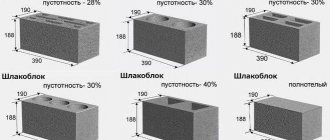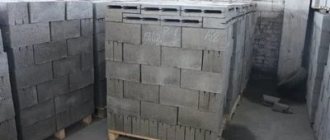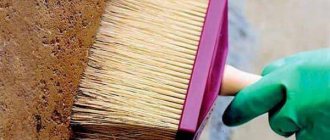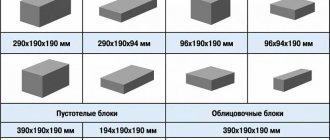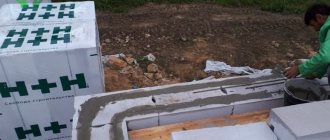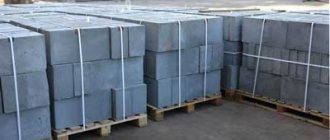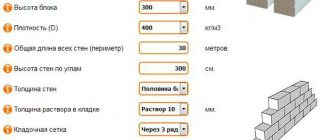In the modern world, many construction products are supplied in pallets, which can be covered with a special film to preserve their quality. This also applies to products made using a foaming agent.
How many products are in one pallet – we’ll figure it out!
Thus, it is sometimes useful for customers to know how many foam blocks are in one pallet in order to determine consumption and transportation.
Appearance of foam concrete blocks in the photo.
Density
This indicator is proportional to the grade of concrete. Each type of building element is used to lay structures with different loads. In order not to make a mistake when choosing a brand, you should familiarize yourself with their purpose. Aerated concrete D600 is characterized by high strength.
Monoliths are erected from D500 blocks, D 400 - for arranging insulation when installing openings. Products made from aerated concrete D350, which has high porosity and a loose structure, are used primarily for heat insulation.
The material absorbs moisture, so a moisture-insulating soil ball is applied to the walls. The block manufacturing technology involves mixing the ingredients, which, when interacting, form a porous structure. High-density building elements have more weight.
How much aerated concrete in a cube can be determined by the density of the block. This indicator is designated D, and the numbers after the letter marking indicate the density value. A low index value corresponds to the presence of a large number of air pores, which increase heat conductivity.
The strength index of the D400 gas block is 45% higher than that of D300, but the thermal conductivity is 30% lower. The price of building products of the D400, 200, 300, 600 cm brand in Moscow and other regions is lower than for similar products of higher density.
Currently reading: Recommended concrete pouring temperatures
Foam concrete and its characteristics
Foam concrete is an artificial stone, a type of concrete, but made, unlike it, using a foaming agent. The foaming agent is SDO - saponified wood resin. It gives the material plasticity, frost resistance, elasticity, and has antiseptic properties. Otherwise, foam concrete does not differ in composition from concrete: cement + sand + water.
Foam concrete is often confused with aerated concrete. In fact, these are completely different materials. Aerated concrete is made using hydrogen, a gas that is released during a certain chemical reaction. As a result, through pores are formed in it. The pores in foam concrete are closed, which makes the waterproofing characteristics of the material much higher. If you place a foam block in water, it will immediately float up, but the same experiment with aerated concrete will lead to the aerated block being saturated with water within a couple of hours and sinking.
The foam block optimally combines properties that are attractive to developers:
- environmental friendliness, sound insulation, thermal insulation;
- light weight of the material, speed of construction;
- fire safety, ease of processing, affordable price.
The composition, rules of use and various instructions for the production of foam concrete are regulated by regulatory documents - GOSTs, which the manufacturer must comply with. These include:
- GOST 25485-89 “Cellular concrete. Technical conditions";
- SN 277-80 “Instructions for the manufacture of products from cellular concrete”;
- GOST 5742-76 “Heat-insulating products made of cellular concrete”;
- GOST 12852.0-77 “Cellular concrete. General requirements for test methods."
Pros and cons of the material
The appearance of cinder blocks is directly related to man’s natural desire for waste-free production. In the USSR in the post-war years, production developed at a rapid pace. Metallurgical plants were literally overgrown with mountains of slag. Then the decision came to use this waste to create building materials.
The slag served as a filler for the cement-sand mixture. The resulting mass was molded into large “bricks”. The finished blocks were too heavy - they weighed 25-28 kg. To reduce weight, voids were made in them. Hollow specimens turned out to be a little lighter - from 18 to 23 kg with standard dimensions.
The name cinder blocks is still used today, although not only slag, but also other components are used as fillers. In modern blocks you can find granite screenings or crushed stone, river gravel, broken glass or expanded clay, and volcanic mass. The production of cinder blocks is most often carried out by small businesses. Small private enterprises produce building blocks on vibrating machines, filling several molds with cement mixture at once. After molding and compacting, the “bricks” gain strength for at least a month.
Cinder blocks have certain advantages and disadvantages.
- The advantage of block building material, first of all, is its low cost. That is why the material is in wide demand.
- This building material also has other positive characteristics. For example, blocks do not change their size after laying out. The structure will not shrink, which means that design calculations will not be adjusted during the construction process.
- The strength and hardness of the “big brick” determine its service life. This is neither more nor less – a whole 100 years! Durability is not calculated, but time-tested. There are many buildings from the middle of the last century that “stand firmly on their feet.” The houses are not lopsided or falling apart, only the facades require cosmetic repairs.
- The blocks react poorly to ultraviolet radiation and temperature changes. The material is not edible for rodents and insects.
- Thanks to the increased size, construction is proceeding at a rapid pace. Much less masonry mixture is used for laying blocks than, for example, for a brick wall of similar sizes.
- No street noise can be heard behind a cinder block wall, because it is capable of absorbing sounds.
- Finally, if you have simple equipment and desire, blocks can be made at home, which will further reduce the cost of construction.
The building material has as many disadvantages as advantages.
These include the following characteristics.
- Unprepossessing appearance.
- It is problematic to attach to walls due to voids in the body of the block.
- The need for cladding to make the building attractive and protect the building material from external moisture.
- Fragility. If it falls during work, during transportation or loading, the unit may break.
- High thermal conductivity. Without additional insulation, the building does not retain heat well.
- Wide tolerance limits. Dimensions may differ significantly from nominal.
Determining the weight of foam concrete in a cube
When designing a house, determining the load on the foundation plays an important role. Depending on the magnitude of the load, the type of foundation, its design, and depth are determined. To determine the load on the foundation, you need to know how much a cube of foam block weighs. By calculating the number of cubes needed to build a house and multiplying it by the weight of 1 cube of foam block, we get the load acting on the foundation.
The weight of foam concrete blocks depends on the ratio of sand, cement, and the degree of foaming. The block material is marked with the symbol D, which characterizes the density of the foam block material. If the packaging says D300, this means that one cube of this foam concrete weighs 300 kg. When constructing structures from foam concrete blocks, the foam concrete grade D600 is used.
Each standard size of foam block has its own weight. So, for example, a block with side dimensions of 200 300 600 mm has a weight of 22 kg. Since the blocks are made of the same material, the weight of one cube for all sizes will be approximately the same. It is 580 – 680 kg. The variation in the weight of 1 cubic meter of material is explained by the fact that foam concrete is able to absorb moisture, due to which the weight of the blocks can change.
What sizes are foam blocks?
The blocks used in construction have different sizes and volumes:
- 100x300x600 mm, volume of one block 0.018 cubic meters. meters;
- 120x300x600 mm, volume of one block 0.022 cubic meters. meters;
- 150x300x600 mm, volume of one block 0.027 cubic meters. meters;
- 200x300x600 mm, volume of one block 0.036 cubic meters. meters;
- 250x300x600 mm, volume of one block 0.045 cubic meters. meters;
- 200x400x600 mm, volume of one block 0.048 cubic meters. meters;
But blocks can also be of non-standard size, made to order.
For example, when measuring it was 300x400x600 mm. To calculate its volume, which we need to calculate its quantity in pieces on a pallet, the obtained data should be converted into meters. There are 1000 millimeters in one meter, the size of one side of the block is 300 millimeters. This means we divide 300 by 1000 and get 0.3 meters. We do the same calculations with other sizes of the sides of the block.
We get the size of the foam block in meters:
- 0.3×0.4×0.6 m;
Next, you need to calculate the volume; to do this, make the following calculations by multiplying:
- 0.3 * 0.4 * 0.6 = 0.072 cubic meters meters in one block;
As you can see above, by multiplying the length, width and height of the foam block, we find out its volume in cubic meters.
Main settings
A foam concrete block is a building material that resembles a brick in shape, but its dimensions are much larger. It is for this reason that work on the construction of buildings takes place in a short time, which cannot be said about the construction of bricks. One unit of the most common format (200x300x600 mm) in a masonry can replace 13 white and 15 red bricks .
Types of products
Before determining how many foam blocks are in a pallet, you need to familiarize yourself with the types of products .
The division is carried out based on density indicators, since this is what affects the strength and some other characteristics, on which the use of the material also depends.
- The thermal conductivity of the foam block is quite low. Thermal insulation products are actively used to insulate the side planes of load-bearing structures. Concrete grades used: 400 and 500. Strength is 9 kg/sq.m. cm.
- Structural thermal insulation blocks are a good material for the construction of walls and additional insulation of buildings. Concrete grades: from 600 to 900. Capable of withstanding 16-35 kg/sq.m. cm.
- Structural analogues are ideal for constructing external walls and other load-bearing parts. Concrete grades used: 1000-1200. They can withstand loads from 50 to 90 kg/sq.m. cm.
Standard product sizes are presented.
Note! Of course, the price of the final product largely depends on the density category. However, developers have an excellent opportunity to choose the best option.
Common sizes
The volume of one unit of material can be different, which can affect the labor intensity and speed of construction, especially if the work is done with your own hands.
As for professional workers, for them the dimensions of the product play a small role, since special equipment and structures are used in the process.
- 200x300x600 mm is a very popular block format, which allows, when laid on edge, to create a 20 cm layer for internal partitions and external walls with additional thermal insulation.
- 200x400x600 mm is a fairly common size, providing the opportunity to form external planes without carrying out insulation and sound insulation work.
- 100x300x600 mm - this format is most often used for the construction of internal walls.
Recommendation! When choosing dimensions, it is recommended to pay attention to the thickness of the product, because it is this parameter that affects the heat and sound insulation characteristics of the created plane.
